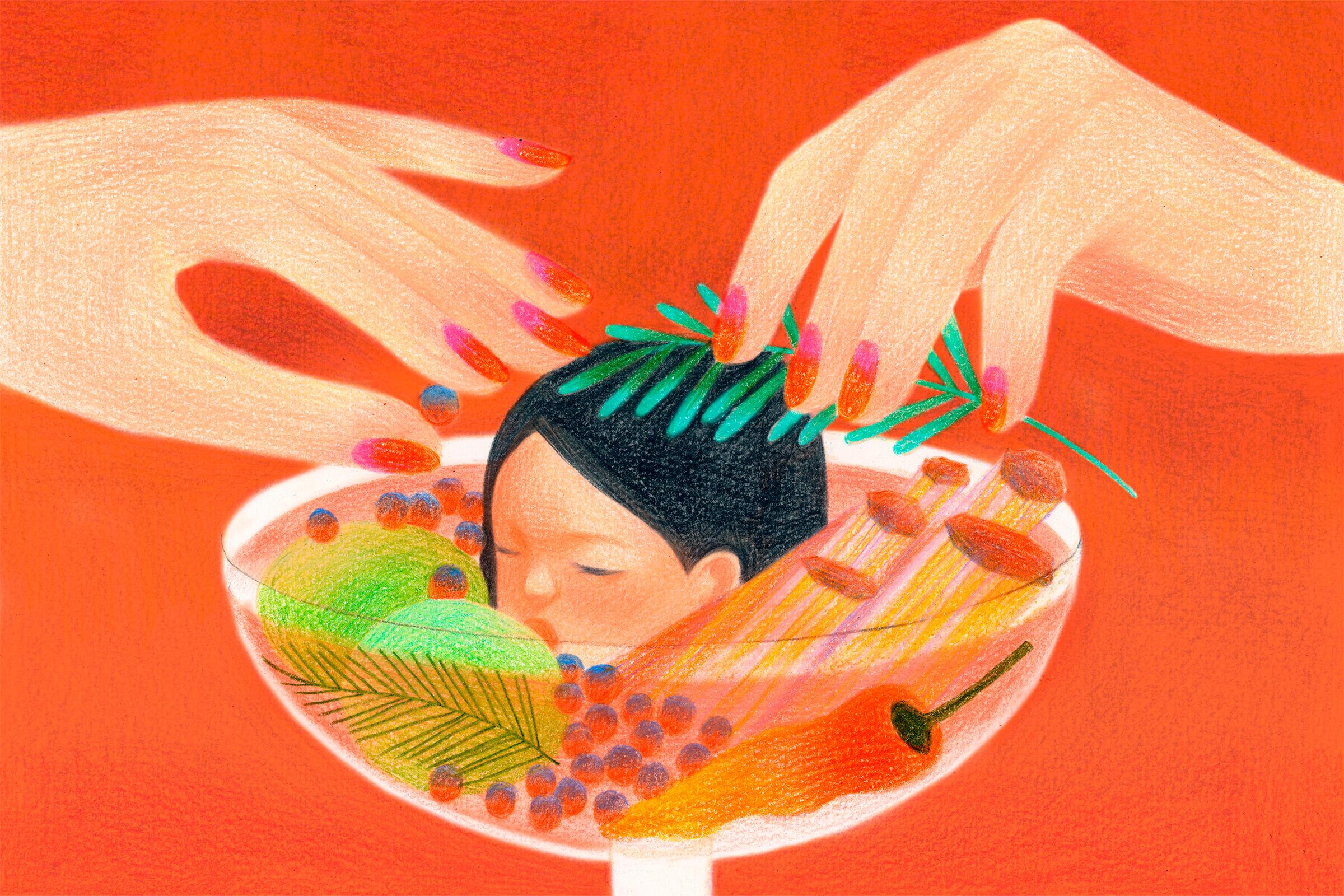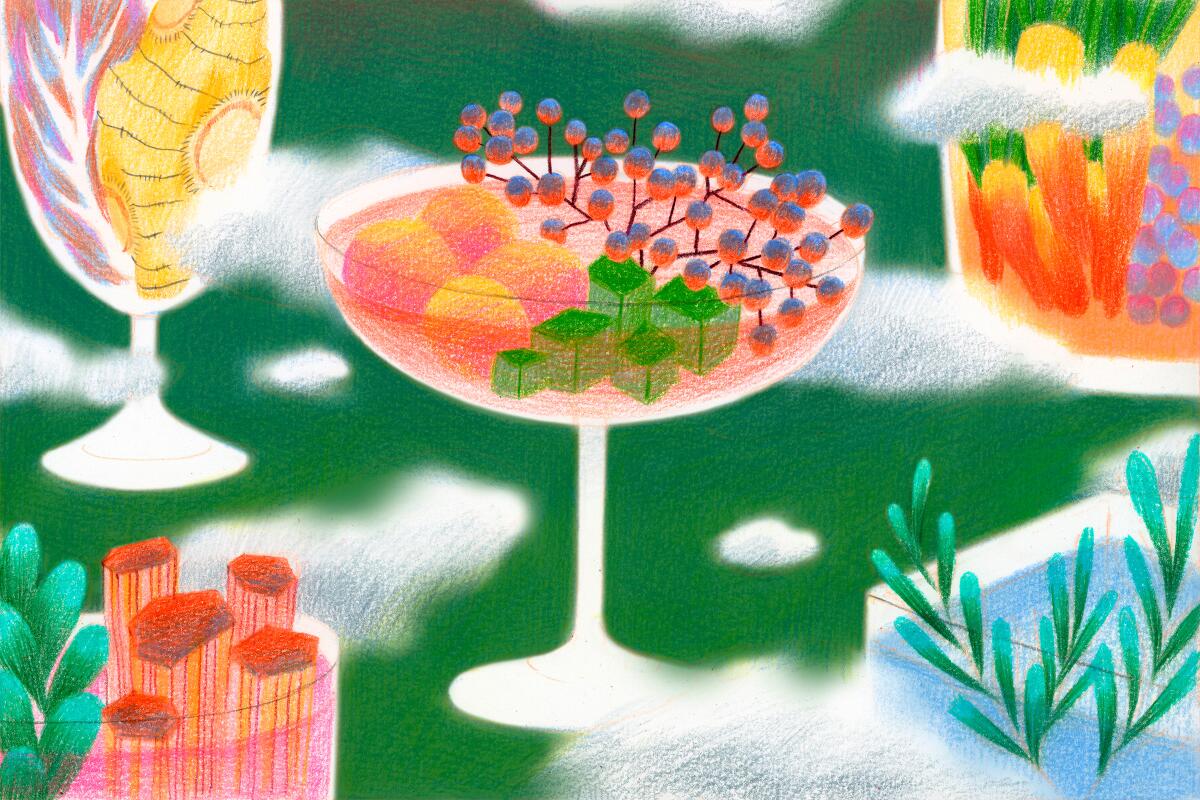Newsletter
Eat your way across L.A.
Get our weekly Tasting Notes newsletter for reviews, news and more.
You may occasionally receive promotional content from the Los Angeles Times.

When I was a tender adolescent, maybe 11 years old, I was at my friend Jane’s house for a sleepover. Jane’s older brother Mark had friends over too. One boy we deemed especially cute, so we decided to mix a drink for him. We poured Coke into a glass, then added a little Worcestershire sauce, some Tabasco, a dribble of pickle juice, a squirt each of ketchup and mustard. We stirred it up — it still looked like Coke, with a bit of scum on top you’d have to be sharp to notice — and carried it to the cute boy lounging on the sofa.
“Here, we made you a drink.”
The poor trusting teenager took a big mouthful — and sprayed it right back out, all over the art books on the coffee table.
In the decades since, I’ve recalled that incident — what were we thinking? — but never so often as I have recently, with the proliferation of new nonalcoholic drinks on the market.
I mean, nonalcoholic peanut butter “stout,” anyone? With strong notes of vinegar, molasses and peanut butter?
I have not imbibed an alcoholic beverage for 36 years — although I had my share before then.
For the first 10 of my sober years, the thought of “replacing” an alcoholic beverage with a de-alcoholized one or a zero-proof simulacrum seemed risky, as if getting that close to the addictive substance would trigger a relapse. So when others were sipping wine, mixed drinks or beer, I clutched a glass of fizzy water. Or, on special occasions, Martinelli’s carbonated apple juice. Occasionally, a bartender served me a cranberry-and-soda. But I have never cared for sweet drinks.
In my drinking days, I liked good yeasty beers, wine that was dry and crisp or full-bodied (when I remembered to taste it), and the smoky, peaty taste of Scotch (when I remembered to sip it). In sobriety, I have missed the complexity and depth of flavor in such drinks.
I have also missed the ceremonial, celebrational aspects of drinking — the measuring, stirring and garnishing — of mixed drinks. The juicy rasp of the martini shaker. The uncorking of wine.
And the glassware! As a child, I was entranced by the glass and crystal in my parents’ liquor cabinet: the prismatic glints of shallow Champagne coupes and more severe martini glasses, the bulbous brandy snifters and heavy-bottomed glasses for old fashioneds, all of them rarely used. My mother, coming home from work, usually poured herself a stiff one in a tall green plastic tumbler.
Alcohol-free spaces are a way to foster inclusion and well-being, while dismantling the standards of alcohol consumption that were rooted in colonialism.
I had my first nonalcoholic beer — in a pilsner glass! — when I was 10 years sober, and was doubly surprised: first, that it tasted like beer (at least according to my 10-year-old memory of beer). And then — this was the strangest thing — I didn’t immediately want another one.
Still, a nonalcoholic beer might be what I ordered when others were having a cocktail — that is, if the restaurant bothered to stock it. Some waiters and bartenders apologized for not having any while others sneered at the request: “What’s the point?” they said.
I’d occasionally be talked into a “mocktail,” which too often was just fruit juice and fizzy water.
But times have changed. There’s a whole, wild new world of interesting liquids for sober drinkers. And for entrepreneurs there’s a whole new market to supply for alcohol-avoiding consumers, as well as those the industry likes to call “the sober curious.”

Looking for mocktail options for the new year? Check out these Los Angeles spots that focus on nonalcoholic cocktails or the ingredients for at-home pours.
What took so long? After all, it’s no longer news that in many countries around the world, young people are drinking less. As European Supermarket Magazine reported this year, “Studies by multiple research institutions show that Generation Z consumers drink 20% less alcohol than Millennials — and that Millennials are already drinking less than Generation X and Baby Boomers.”
Not only has there been a huge influx of new non-A beers, mocktails (now a retro term) have become more sophisticated. To create complex nonalcohol flavors, mixologists have turned to, among other things, the deep, strong flavors of botanicals like gentian, cinchona (quinine), elderberry and other fruit and flower essences, as well as yuzu, juniper berries, various herbs, spices and spice mixes, vinegars, verjus (unripened grape juice), flavored oils and specialty teas.
The often intense and/or surprisingly complex new concoctions provide at least some of the side pleasures of alcohol — the ceremonial and aesthetic; the sense of specialness; the chance to drink from fancy glassware.
All of these new alcohol-free beverages, of course, are not soda-pop cheap. They’re liquor expensive. Alcohol pricing has always famously been inflated — and non-A drink manufacturers are following this lead. For many customers, however, that pricing — along with elegant packaging — at least shows that the industry now takes them seriously as consumers.
Fine-dining restaurants have also started taking NA consumers seriously, with many of the world’s most highly rated restaurants offering non- and low-alcohol pairings alongside wine pairings for their multicourse tasting menus.
I had my first nonalcoholic pairing (45 euros compared with the 70-euro wine pairing) with a tasting menu this fall at Le Petit Léon in France’s Dordogne. Our server said the restaurant devised its non-A selections by talking about the specific flavors and sensations in the wine pairings, and how they might hit similar notes in each nonalcoholic offering. Ingredients ranged from rooibos tea to fig leaf oil, chai spices to yuzu. My favorite pairing came with a delicate trout dish: It was a mild, clear yellow drink with a buttery and hauntingly familiar flavor — chamomile, it turned out, “steeped to bitterness,” then thinned to a hint, with a little honey for sweetness, and — surprise — melted butter stirred in, chilled, then removed once it hardened.
I’ve been trying to re-create that lovely drink ever since, and my failure to do so makes me appreciate how much R&D must go into the best creative new drinks — and must be, in part, what we’re paying for: hours of careful chemistry. Hopefully, at some point in the future, a few of the best alcohol-free concoctions will, like Big Pharma products, come in generic, low-priced versions.
Meanwhile, I have to admit that some of the new beverages are delicious — so much so that even alcohol drinkers enjoy them.
I love the bitter Aperol and Campari taste-alikes: Martini and Rossi’s Vibrante and Lyre’s Italian Spritz, among others. We mix them with club soda. Another favorite is Top Hat’s quinine-intense Sugar-Free Elderflower Tonic Syrup mixed with club soda and a dash of bitters. But NA drinker beware. Not every pricey new zero-proof beverage goes down easy.
My friend Hilary, long sober, has a whole liquor cart of nonalcoholic spirits and invited me over to taste some.
A snort of Wilfred’s Bitter Orange and Rosemary was sweet, sippable and pleasantly intense. Something Spritzy from Trader Joe’s was a not-too-sweet, sophisticated soda pop.
“It would be one of my favorites,” Hilary confided, “but it’s not special enough, it doesn’t work in the same way this one does,” she said, and poured me some Ghia chile-and-lime spritz, which had a compelling gentian bitterness and spicy heat, plus artful packaging and a far heftier price tag.
Proof, I thought, that cool packaging and high prices do intoxicate.
I’d never tasted anything quite like Gnista Barrelled Oak, a whiskey-brown “spirit” that was warm and buttery, sweet and salty, like toffee dissolved in water. Strange. But one might eventually get used to it.
“All very interesting,” I said. “But nothing remotely reminds me of alcohol.”
“We’re gettin’ to it,” Hilary said, and poured me a generous finger of SOM Thai Basil “cane vinegar cordial.” Again, sweet. And intense: The vinegar burned my sinuses, but I didn’t find it pleasurable.
Hilary next snapped open a can of Sovi de-alcoholized sparkling rosé, which did taste like a crisp, dry rosé wine — at least to someone who hasn’t tasted a real rosé in 36 years. Yum! (And it was priced like a real rosé too, at $30 for a four-pack of 250-milliliter cans.)
Rumish Dark Spiced Spirit. Seedlip Spice 94. Dram Herbal Bitters. Three Spirit Nightcap. Amass Riverine. I felt like a newbie at the bar being introduced to what were clearly acquired tastes.
“And here is my favorite after-dinner drink,” Hilary said. “My husband calls it my barbecue sauce.” She poured me a glug of dark brown liquid from a dark brown bottle of Curious Elixirs #5, a “smoked chocolate cherry old-fashioned.”
I took a good swig. Oh, ho! It was intense all right!
Hilary burst out laughing. “The look on your face!”
With elderberry, ginger, chicory and cayenne along with the “legendary aphrodisiac shatavari,” this thick, sour, sweet, chile-hot, molasses-y, vinegary potion took me straight back to my 11-year-old self and my mixology experiment — only now, I was the one drinking. I was too polite to spit it out. Reader, I swallowed it.
Huneven’s latest novel is “Search” (Penguin Press).
Eat your way across L.A.
Get our weekly Tasting Notes newsletter for reviews, news and more.
You may occasionally receive promotional content from the Los Angeles Times.